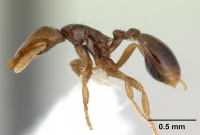Strumigenys turpis
| Strumigenys turpis | |
|---|---|

| |
| Scientific classification | |
| Kingdom: | Animalia |
| Phylum: | Arthropoda |
| Class: | Insecta |
| Order: | Hymenoptera |
| Family: | Formicidae |
| Subfamily: | Myrmicinae |
| Tribe: | Attini |
| Genus: | Strumigenys |
| Species: | S. turpis |
| Binomial name | |
| Strumigenys turpis (Bolton, 2000) | |
Bolton described the species based on material from cloud forest in southern Mexico. I have one specimen from Costa Rica that I tentatively identify as turpis. It was collected by Jenny Jacobs on Isla Pelada, one of the small offshore islands in the Guanacaste Conservation Area. It was in a litter sample. (Longino, Ants of Costa Rica)
Identification
Bolton (2000) - A member of the azteca-complex in the Strumigenys excisa-group. The non-paratypic material is distinctly more hairy than the holotype, with obviously more than 6 hairs on the cephalic dorsum and these not restricted to immediately in front of the occipital margin. Dorsolateral margin of head has 1-3 fine simple projecting hairs, one of which is in apicoscrobal position. These differences from the holotype may indicate the presence of two sibling species, or may be part of the normal variation of this species, or may suggest that the holotype had been abraded; the acquisition of more material is needed to show which is the correct interpretation.
Longino (Ants of Costa Rica) - Mandible short and curving downward in profile; lateral head capsule with the antennal scrobe mostly or entirely smooth and shining; propodeal spines present (former Glamyromyrmex); leading edge of scape lacking erect setae; disc of postpetiole in dorsal view very broadly U-shaped or V-shaped, with an extremely deeply concave anterior face; spongiform tissue absent from ventral surface of petiole, postpetiole and first gastral sternite; head in side view convex above and below, not flattened; about 8 erect setae near posterior margin of face and a few erect setae projecting from sides of head; petiolar node in dorsal view wider than long; gaster in lateral view tear drop shaped, strongly concave anteriorly near insertion of postpetiole. Similar to Strumigenys rogata.
Keys including this Species
Distribution
Latitudinal Distribution Pattern
Latitudinal Range: 19.51666667° to 15.132°.
| North Temperate |
North Subtropical |
Tropical | South Subtropical |
South Temperate |
- Source: AntMaps
Distribution based on Regional Taxon Lists
Neotropical Region: Costa Rica, Guatemala, Mexico (type locality).
Distribution based on AntMaps
Distribution based on AntWeb specimens
Check data from AntWeb
Countries Occupied
| Number of countries occupied by this species based on AntWiki Regional Taxon Lists. In general, fewer countries occupied indicates a narrower range, while more countries indicates a more widespread species. |

|
Estimated Abundance
| Relative abundance based on number of AntMaps records per species (this species within the purple bar). Fewer records (to the left) indicates a less abundant/encountered species while more records (to the right) indicates more abundant/encountered species. |

|
Biology
Castes
Nomenclature
The following information is derived from Barry Bolton's Online Catalogue of the Ants of the World.
- turpis. Pyramica turpis Bolton, 2000: 176 (w.) MEXICO. Combination in Strumigenys: Baroni Urbani & De Andrade, 2007: 130
Unless otherwise noted the text for the remainder of this section is reported from the publication that includes the original description.
Description
Worker
Holotype. TL 2.0, HL 0.54, HW 0.44, CI 81, ML 0.11, MI 20, SL 0.22, SI 50, PW 0.26, AL 0.54. With head in full-face view anterior clypeal margin extremely shallowly concave, almost transverse. Lateral margins of clypeus convex, separated from margins of frontal lobes by distinct impressions. Lateral outline of frontal lobe broadly shallowly convex but upper scrobe margins narrower than frontal lobes and shallowly concave, so that the outline has a distinctly pinched-in appearance behind the frontal lobes. Dorsolateral margin of head with a si mple apicoscrobal hair. Dorsum of head with an arched transverse row of 6 short erect hairs in front of the occipital margin; dorsum otherwise without standing hairs. Eye with 6-7 ommatidia in total. Arch of anteroventral margin of head in front of eye low, broad and shallow, the arch spanned by a thin cuticular carina. Pronotal humeral hair simple; dorsa of both pronotum and mesonotum with a number of erect simple hairs, especially on the dorsolateral margins. Dorsum and sides of alitrunk glassy smooth everywhere. Suberect to erect short simple hairs present on waist segments and on first gastral tergite, where 4-6 pairs occur on the basal half. Basigastral costulae sharply defined dorslaterally, the spaces between them finely superficially shagreenate.
Type Material
Holotype worker, Mexico: Oaxaca, 15 mi. S Valle Nacional, 4000 ft, 21.v.1971, B-204 (S. Peck) (Museum of Comparative Zoology).
References
- Baroni Urbani, C. & De Andrade, M.L. 2007. The ant tribe Dacetini: limits and constituent genera, with descriptions of new species. Annali del Museo Civico di Storia Naturale “G. Doria”. 99:1-191.
- Bolton, B. 2000. The ant tribe Dacetini. Memoirs of the American Entomological Institute. 65:1-1028. (page 176, worker described)
References based on Global Ant Biodiversity Informatics
- Bolton, B. 2000. The Ant Tribe Dacetini. Memoirs of the American Entomological Institute 65
- Dattilo W. et al. 2019. MEXICO ANTS: incidence and abundance along the Nearctic-Neotropical interface. Ecology https://doi.org/10.1002/ecy.2944

